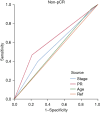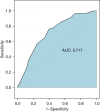Comparison of clinical characteristics and pathologic complete response rate after neoadjuvant chemotherapy in women under 35 years and older women with breast cancer
- PMID: 39678411
- PMCID: PMC11635561
- DOI: 10.21037/gs-24-293
Comparison of clinical characteristics and pathologic complete response rate after neoadjuvant chemotherapy in women under 35 years and older women with breast cancer
Abstract
Background: Age has been confirmed as a very aggressive biological factor associated with the poor prognosis of breast cancer (BC) patients. However, the understanding of young women with breast cancer (YWBC) is scarce. This study compares and evaluates the clinical characteristics and pathologic complete response (pCR) rate after neoadjuvant chemotherapy (NAC) in YWBC and older women with BC.
Methods: We retrospectively analyzed the clinicopathological data and pCR rates of 1,419 non-metastatic BC patients from the Harbin Medical University Cancer Hospital from 1 January 2012 to 31 December 2019. Patients were classified according to age (≤35 vs. >35 years old) with the clinical parameters. The chi-squared or Fisher's exact test was used to evaluate the correlation between clinicopathological variables and pCR. Any predictor variables with P<0.05 in the univariate analysis were included in the multivariate regression analysis to study the relationship between different age groups and pCR.
Results: A total of 879 patients in this study were eligible for analysis, and 71 (8.1%) female patients were ≤35 years old. Compared with elderly patients, YWBC were more likely to achieve pCR (25.4% vs. 15.6%, P=0.03) and undergo breast-conserving surgery (BCS). There was a higher proportion of clinically higher stage in the YWBC group. Patients with YWBC, clinical stage I+II, positive human epidermal growth factor receptor 2 (HER-2) expression, negative progesterone receptor (PR) expression, and KI67 >15% were more likely to achieve pCR (P<0.05).
Conclusions: Our study found that age is the main factor affecting the achievement of pCR in patients with BC. Chemotherapy is more effective in patients with YWBC. We need to pay more attention to this group and achieve individualized treatment, which will facilitate improved treatment of BC and provide new targets and blueprints for clinical therapy.
Keywords: Breast cancer (BC); body mass index (BMI); neoadjuvant chemotherapy (NAC); pathologic complete response (pCR); young women with breast cancer (YWBC).
2024 AME Publishing Company. All rights reserved.
Conflict of interest statement
Conflicts of Interest: All authors have completed the ICMJE uniform disclosure form (available at https://gs.amegroups.com/article/view/10.21037/gs-24-293/coif). The authors have no conflicts of interest to declare.
Figures







Similar articles
-
Clinical characteristics and pathologic complete response (pCR) rate after neoadjuvant chemotherapy in postpartum women with breast cancer.J Cancer Res Clin Oncol. 2023 Nov;149(15):14185-14204. doi: 10.1007/s00432-023-05194-z. Epub 2023 Aug 9. J Cancer Res Clin Oncol. 2023. PMID: 37555951 Free PMC article.
-
Estrogen receptor-negative/progesterone receptor-positive breast cancer has distinct characteristics and pathologic complete response rate after neoadjuvant chemotherapy.Diagn Pathol. 2024 Jan 4;19(1):5. doi: 10.1186/s13000-023-01433-6. Diagn Pathol. 2024. PMID: 38178166 Free PMC article.
-
Real-world data on breast pathologic complete response and disease-free survival after neoadjuvant chemotherapy for hormone receptor-positive, human epidermal growth factor receptor-2-negative breast cancer: a multicenter, retrospective study in China.World J Surg Oncol. 2022 Sep 29;20(1):326. doi: 10.1186/s12957-022-02787-9. World J Surg Oncol. 2022. PMID: 36175898 Free PMC article.
-
A nomogram to predict pathologic complete response (pCR) and the value of tumor-infiltrating lymphocytes (TILs) for prediction of response to neoadjuvant chemotherapy (NAC) in breast cancer patients.Breast Cancer Res Treat. 2019 Jan;173(2):255-266. doi: 10.1007/s10549-018-4981-x. Epub 2018 Oct 15. Breast Cancer Res Treat. 2019. PMID: 30324273 Review.
-
Breast cancer under age 40: a different approach.Curr Treat Options Oncol. 2015 Apr;16(4):16. doi: 10.1007/s11864-015-0334-8. Curr Treat Options Oncol. 2015. PMID: 25796377 Review.
References
-
- Santos P, Barnes J, Boe L, et al. Identifying modifiable risk factors to improve immigrant breast cancer screening in the United States. J Clin Oncol 2024;42:abstr 1530.
LinkOut - more resources
Full Text Sources
Research Materials
Miscellaneous
